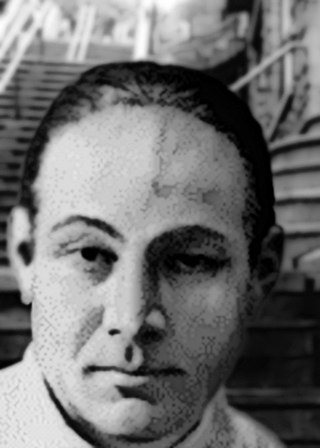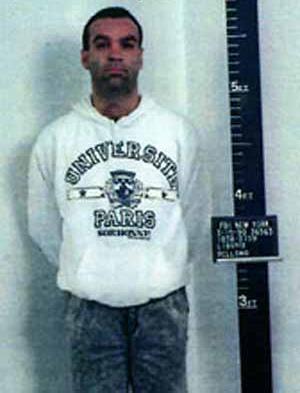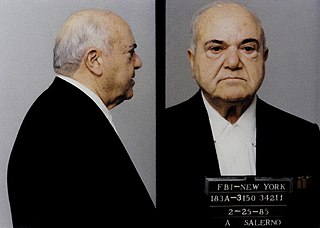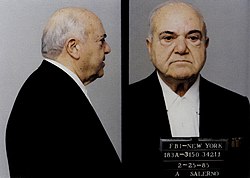
Giuseppe "Joe the Boss" Masseria was an early Italian-American Mafia boss in New York City. He was boss of what is now called the Genovese crime family, one of the New York City Mafia's Five Families, from 1922 to 1931. In 1930, he battled in the Castellammarese War to take over the criminal activities in New York City. The war ended with his murder on April 15, 1931, in a hit ordered by his own lieutenant, Charles "Lucky" Luciano, in an agreement with rival faction head Salvatore Maranzano.
The Genovese crime family, also sometimes referred to as the Westside, is an Italian-American Mafia crime family and one of the "Five Families" that dominate organized crime activities in New York City and New Jersey as part of the American Mafia. They have generally maintained a varying degree of influence over many of the smaller mob families outside New York, including ties with the Philadelphia, Patriarca, and Buffalo crime families.
Nicolò Terranova, also known as Nicholas "Nick" Morello, was one of the first Italian-American organized crime figures in New York City. He succeeded Giuseppe Morello as boss of the then Morello Gang in 1909 and was succeeded by Vincenzo Terranova in 1916. Along with his half-brother Giuseppe Morello and brothers Ciro and Vincenzo Terranova, he founded the Morello crime family, and was later one of the participants in the Mafia-Camorra War of 1915–17.

Giuseppe "the Clutch Hand" Morello, also known as "The Old Fox", was the first boss of the Morello crime family and later top adviser to Giuseppe "Joe the Boss" Masseria. He was known as Piddu and his rivals the Castellammarese knew him as Peter Morello. He was famous for having a one-fingered deformed right hand that resembled a claw.

The Morello crime family was one of the earliest crime families to be established in the United States and New York City. The Morellos were based in Manhattan's Italian Harlem and eventually gained dominance in the Italian underworld by defeating the rival Neapolitan Camorra of Brooklyn. They were the predecessors of what eventually became known as the Genovese crime family.

The Five Families refer to five Italian American Mafia crime families that operate in New York City. In 1931, the five families were organized by Salvatore Maranzano following his victory in the Castellammarese War.

Underboss is a position within the leadership structure of certain organized crime groups, particularly in Sicilian, Greek, and Italian-American Mafia crime families. The underboss is second in command to the boss. The underboss is also person-in-charge of all capos and its soldiers. The underboss is sometimes a family member, such as a son, who will take over the family if the boss is sick, killed, or imprisoned. However the position of street boss has somewhat challenged the rank of underboss in the modern era. The position was installed within the Genovese crime family since at least the mid-1960s. It has also been used in the Detroit crime family and the Chicago Outfit.

Ciro Terranova was an Italian-born New York City gangster and one time underboss of the Morello crime family.
Philip Lombardo also known as "Benny Squint" and "Cockeyed Phil", was the boss of the Genovese crime family from the late 1960s until the beginning of the 1980s. He succeeded Vito Genovese as Boss in 1969 and was succeeded by Vincent Gigante in 1981.
The Mafia–Camorra War was a gang war in New York City that lasted from 1915–1917. On one side was the originally Sicilian Morello crime family of Manhattan; on the other side were gangs originally from Naples and the surrounding Campania region, based in Navy Street in Brooklyn and Coney Island referred to as the Camorra. The fight over the control of the New York rackets started after the killing of Giosue Gallucci, the undisputed King of Little Italy, and his son on May 17, 1915. The trials that followed in 1918 completely smashed the Camorra gangs; the protection that they enjoyed was demolished from the testimonies of their own men. It was the end of the Camorra in New York and the rise in power of American-based Sicilian Mafia groups.
Vincenzo "the Tiger of Harlem" Terranova was a gangster and an early Italian-American organized crime figure in the United States. He succeeded Nicholas Morello as boss of the then Morello Gang in 1916 and was succeeded in turn by Giuseppe Masseria in 1922. He served as boss and underboss of the Morello crime family, today known as the Genovese crime family, the oldest of the Five Families in New York City.
Peter DeFeo, also known as "Philie Aquilino", was a New York mobster who became a caporegime with the Genovese crime family.
Vincent DiNapoli was a caporegime in the Genovese crime family, involved in labor racketeering. DiNapoli is best known for creating a cartel in the 1970s that controlled the price of drywall in New York City.

Liborio Salvatore “Barney” Bellomo is an American mobster and boss of the Genovese crime family of New York City. Bellomo was a member of the 116th Street Crew of Saverio "Sammy Black" Santora.
Pellegrino Morano (1877–unknown) was the head of a group of Neapolitan criminals with roots in the Camorra based in Coney Island, where he owned the Santa Lucia restaurant, which was often used as the headquarters for their gang, known as the Coney Island gang. He is also known as Marano.
The East Harlem Purple Gang was a gang or organized crime group consisting of Italian-American hit-men and heroin dealers who were semi-independent from the Italian-American Mafia and, according to federal prosecutors, dominated heroin distribution in East Harlem, Italian Harlem, and the Bronx during the 1970s and early 1980s in New York City. Though mostly independent of the Italian-American Mafia and not an official Mafia crew, the gang was originally affiliated with and worked with the Lucchese crime family and later with the Bonanno crime family and Genovese crime family. It developed its "closest ties" with the Genovese family, and its remnants or former members are now part of the Genovese family's 116th Street Crew.
The Lucchese crime family is an Italian-American Mafia crime family and one of the "Five Families" that dominate organized crime activities in New York City, within the nationwide criminal phenomenon known as the American Mafia. Members refer to the organization as the Lucchese borgata; borgata is Mafia slang for criminal gang, which itself was derived from a Sicilian word meaning close-knit community. The members of other crime families sometimes refer to Lucchese family members as "Lukes".
The Genovese crime family's New Jersey faction is a group of Italian-American mobsters within the Genovese crime family who control organized crime activities within the state of New Jersey. The New Jersey faction is divided into multiple crews each led by a different caporegime who oversees illegal criminal activities in labor racketeering, illegal gambling, loansharking and extortion. The Genovese crime family's New Jersey faction has maintained a strong presence in the Northern Jersey area since the early prohibition era. A number of powerful mobsters within the New Jersey faction such as Guarino "Willie" Moretti, Gerardo "Jerry" Catena and Louis "Bobby" Manna have each held positions within the Genovese family's administration. From the 1990s until his death in 2010, Tino "the Greek" Fiumara was one of the most powerful caporegimes in the New Jersey faction.

Anthony "Fat Tony" Salerno was an American mobster who served as underboss and front boss of the Genovese crime family in New York City from 1981 until his conviction in 1986.
Umberto "The Ghost" Valenti was a Sicilian-born New York City gangster and prominent member of the D'Aquila crime family during the 1910s. He is frequently confused with Rocco Valenti, a Camorra gunman of the same era.








